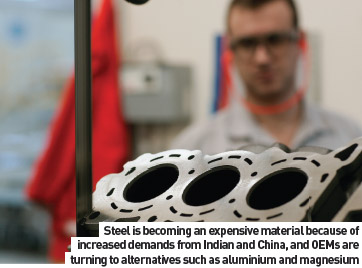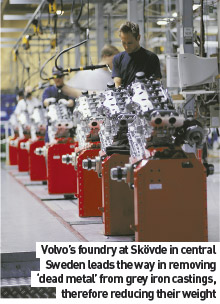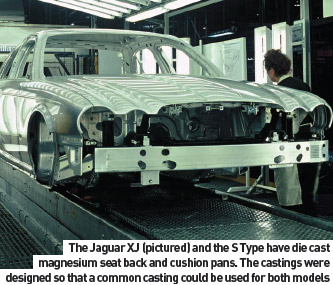Demand for steel has sent prices for the metal rocketing, but alternatives such as aluminium and magnesium are being combined to find favour with carmakers.
It’s a sad irony that the world seems to be striving for the antithesis of Colin Chapman’s mantra “simplify and add lightness” (sometimes also ascribed to Harry Hawker). More gadgets for the customer, extra safety features mandated by legislators are all pushing up complexity and weight. At the same time, rising greenhouse gases and dwindling fuel supplies are forcing engineers into greater innovation to reduce fuel consumption and pollution.
The law of diminishing returns has already kicked in with regard to trying to solve the problem with technology, with perhaps the Toyota Hybrid Synergy Drive marking the technology threshold beyond which few customers are prepared to go now. This just leaves weight as the ‘final frontier’.
Raising the steel bar for safety
 The steel industry has chosen to reduce material volume by going high strength and ultra-high strength, following the ULSAB initiatives. This also produces unprecedented NCAP safety ratings that raise the bar for those OEMs using or evaluating other lighter weight materials. The other downside for steel is that because of demand from China and India it’s getting expensive, especially in its highs trength varieties. This is not close to challenging the price of aluminium and magnesium, but it marks the start of price being an issue for steel.
The steel industry has chosen to reduce material volume by going high strength and ultra-high strength, following the ULSAB initiatives. This also produces unprecedented NCAP safety ratings that raise the bar for those OEMs using or evaluating other lighter weight materials. The other downside for steel is that because of demand from China and India it’s getting expensive, especially in its highs trength varieties. This is not close to challenging the price of aluminium and magnesium, but it marks the start of price being an issue for steel.
It’s interesting that Hydro Aluminium announced recently its intention move away from the automotive industry, joining the growing list of diversified suppliers including Motorola and ThyssenKrupp who made similar decisions earlier in 2006. The move has been attributed to carmakers sourcing products made from cheaper metals or materials.
Although Hydro will continue to deliver aluminium tubing, and rolled and extruded aluminium products to the automotive industry, it will divest its automotive components business, whose product ranges include cast aluminium engine blocks, cylinder heads and a variety of other components.
Hydro’s sister organisation, Norwegian group Norsk Hydro, says the competitiveness, and hence the related profit margins, of the aluminium used in its production of cylinder blocks, heads and crash protection systems, has declined in the face of cheaper alternatives. In the case of engine castings, the traditional material, grey cast iron, has been displaced by aluminium over the last decade or two, chiefly as part of a drive to reduce vehicle weight. The price premium was justifiable where the weight saving could be translated into performance improvements for sports cars, though there was also a fuel consumption benefit.
Advancing foundry techniques in combination with finite element design methods have enabled ‘dead metal’ to be removed from grey iron castings, thereby reducing their weight, while simultaneously maintaining or even enhancing strength and durability. The Volvo group foundry at Skövde in central Sweden has shown the way in that regard.
Weight-saving technology is not an isolated area. It is of primary importance to body and chassis engineers, but it also has ramifications throughout the vehicle.
While performance and economy advantages are a given, the effects on ride and handling must also be considered.
Despite favouring different driven wheels, the fact that both Audi and Jaguar, for example, have adopted air suspension on their larger aluminium-intensive models is no coincidence. As nett vehicle weight is reduced, so the occupants represent a relatively higher proportion of the gross vehicle weight (GVW).
Air suspension ensures that full suspension travel is always available by increasing spring stiffness relative to payload, and that ride height remains constant regardless of the load and its distribution. It can also be programmed to reduce ride height as speed increases, to improve stability and dynamic efficiency.
BMW has long boasted of its products’ almost perfect front-rear weight distribution and air suspension also features on the new 5 Series models. The latest acronym is LAFE (Lightweight Aluminium Front End), a combination of aluminium and steel that uses sophisticated and elaborate joining processes developed by the company's engineers, to ensure optimum connections with supreme precision.
 Depending on material and application, the various components are bonded, riveted, welded or joined by the latest laser processes.
Depending on material and application, the various components are bonded, riveted, welded or joined by the latest laser processes.
LAFE was introduced on the 5 Series and comprises a material mix of aluminium, magnesium, TRIP 700 steel and composite panels. The different joining technologies are not confined to LAFE. Taking approximate figures for the entire body-in-white, 60m of connection seams are bonded, 4,000 spot welds are applied and 70 connection points are bolted. MAG welding, MIG soldering, laser welding and beading, riveting, sub-coating, sealing, clinching and clipping are all employed, with more than 98 per cent of the operations being fully automated.
BMW reckons the model’s all-aluminium chassis has reduced overall weight by about 50 kilograms from the previous generation, despite extra customer equipment in the new car. While the entire body ahead of the A-pillar is made of aluminium, the remainder of the BIW uses high quality steel. The company says this ensures superior strength and rigidity, but it also has much to do with its ‘Holy Grail’ of 50:50 weight distribution.
Fifty-fifty weight distribution
The chassis and suspension of the 5 Series comprise 500 steel and aluminium components weighing just 350kg in total.
Apart from obvious wearing components like thrust rods, wheel bearings and pivot joints, the spring strut tie-bar front axle is made completely of aluminium.
A U-shaped front axle sub-frame, which houses the steering rack, anti-roll bar, track control arms and tie-bars, is reinforced with a thrust plate to ensure transverse stiffness and to aid precision of steering response. For every 10 per cent reduction in vehicle mass, fuel economy improves by an estimated six to eight per cent.
Magnesium alloy, at 1.8g/cm³, is the lightest structural material available. Increasingly it is being used to achieve weight reduction goals and also increased crash worthiness targets of new vehicles.
There are many highly engineered structural magnesium die castings in today’s vehicles, as exemplified by Meridian Technologies’ Meridian Car concept. These parts are designed using the latest CAE tools to meet the ever increasing performance targets for crash performance and weight reduction.
The die cast magnesium instrument panel (IP) structure has been in volume production since the mid-1990s. The first generation parts were typically in the 7-8 kg weight range with wall thickness between 3.5 – 4.0mm. In later generations of magnesium IP structures, the wall thickness and weight has been reduced in spite of increased crashworthiness and NVH / stiffness targets.
Typical late generation magnesium IPs are in the 4.5 – 5kg range with wall thickness between 2.7 – 3.0mm.
This has been achieved with better experience and skills in both FEA tools used to develop the design and also manufacturing process skills. There has also been an increased understanding of the robustness of the magnesium casting processes.
“A well engineered and optimised one-piece die cast magnesium IP structure weighs about 50 per cent less than a comparable steel structure,”
says Glen Simonds, Director – Product Engineering Asia Pacific for Meridian Technologies. “Integration of various fixing points into one casting improves both dimensional capability and repeatability, compared with multi-piece welded steel structures – leading to improved fit and finish and less squeak and rattle issues. Magnesium IP structures consistently meet or exceed NVH and crashworthiness performance targets while still offering substantial weight savings.”
The design trend is for further weight reductions and consequently, Meridian Technologies has IP structures in development with wall thickness in 2.3mm range. “An increased use of thread-forming fasteners is reducing the number of clips and fasteners required, offering further cost savings,” says Simonds. “Meridian has also developed a new approach to the design of a magnesium IP structure called the X-Rib . This new space frame type structure can reduce the weight of a conventional IP by up to 25 per cent – projections are in the region of 45 per cent.”
The first die-cast magnesium front-end structure was launched in production in 2003 on the Ford F 150 pick-up. The one piece casting weighs 6kgs and supports a variety of components including radiators, headlamps, hood latch, crash sensor, horns and wiring harness. The design integrated 12 steel stampings into one casting that saved 12kg forward of the front wheels; it passes 150 per cent of the customer durability requirements and improved the front end fit and finish of the new vehicle.
The thermal processing of high volume aluminium-intensive automobile components has been a key concern of manufactures since their introduction to automotive marketplace in the mid 1960s. Because of long cycle time requirements, furnace engineers were left with limited design options and as a result, designed and manufactured large batch or long linear continuously fed, heat treatment systems.
Users of these systems face cost pressures and are seeking new efficient methods of heat treating high volume aluminium components.
Can-Eng Furnaces has developed a new basketless rotary heat-treating system for the processing of aluminium intensive automobile components. Its Basketless Heat Treating System reduces energy consumption by 40% and floor space requirements by 30% when compared to conventional roller hearth systems.
Product is transferred through the heat treat system without the use of baskets or carriers. The BHTS design results in a more compact footprint with significantly less maintenance requirements. Options exist for unique system layouts, which can be integrated into lean manufacturing cells.
Substantial weight savings forward of the front wheels reduces vehicle weight and improves handling dynamics.
The magnesium structure provides excellent front-end structure and torsional rigidity. The casting has passed all crash testing and is proven to be durable and repeatable in crash situations. Extensive galvanic corrosion protection solutions were tested and the solution in production is robust and economical.
Cast magnesium seat frames offer good weight reduction opportunities. The Jaguar S Type and XJ both have die cast magnesium seat back and cushion pans. The castings were designed so that a common casting could be used for both models and various trim levels within each model range.
The seat cushion tray weighs 1.4kg and the seat back is 1.6kg.
The Jaguar seat frames were designed to pass all crash events including providing high deformation in side impact and passing 50 mph rear impact.
Magnesium seat frames offer weight savings and part integration. The dimensional accuracy of a magnesium diecasting ensures better fit and finish and reduced ‘squeakand- rattle’ issues. Magnesium seat frame castings have been proven to work well in crash, durability and fatigue performances, including high load crash events such as the child seat tether and high-speed rear impact. The 60/40 split seat back with the middle seat belt fixing is as heavy as full width steel structures – typically around 10kg. One of the advantages of the magnesium structure is that the reduced frame weight is ergonomically advantageous for both assembly line and end user.
Current (or mature) magnesium power-train applications include manual transmissions, four-wheel drive transfer cases and cylinder head covers. For the manual transmission and transfer case, AZ91 alloy can be used because of the relatively low operating temperatures of both applications. Both applications can be designed to meet the stiffness and structural rigidity of an aluminium design by the use of FE analysis to develop magnesium specific structural ribbing patterns and localised wall thickness adjustments. Typical weight savings over equivalent aluminium housings is around 25 per cent.
Magnesium castings for automatic housings
While manual transmission housings have been manufactured as castings for a relatively long time, the automatic housing has not. This is due primarily to the high operating temperatures of the automatic. With the relatively recent availability of a wide variety of high temperature (low creep) alloys, the automatic transmission case is an application that is likely to grow significantly in the coming years. Like other powertrain castings, it can be designed in magnesium to meet the structural stiffness in bending and torsion by the engineering of structural rib placement and localized wall thickness to meet the performance targets.
 A weight reduction of 20 per cent should be achievable, compared with an aluminium housing. This equates to potential weight savings of 4kg on a transmission case.
A weight reduction of 20 per cent should be achievable, compared with an aluminium housing. This equates to potential weight savings of 4kg on a transmission case.
With the manual transmission cases and transfer cases in production for many years, galvanic corrosion protection is not a problem.
Key issues with implementing magnesium oil pans relates to the operating temperatures. Like the automatic transmission housing, the increased availability of high temperature alloys opens up the opportunity to develop this application in magnesium. The other design issue relates to the stiffness of the structure, the natural frequency and the acoustical performance (radiant noise). Using the latest FEA tools, it is possible to develop the structural ribbing and localised wall thickness to meet the performance targets.
Also with the experience gained from other power-train components, galvanic corrosion solutions are known.



































